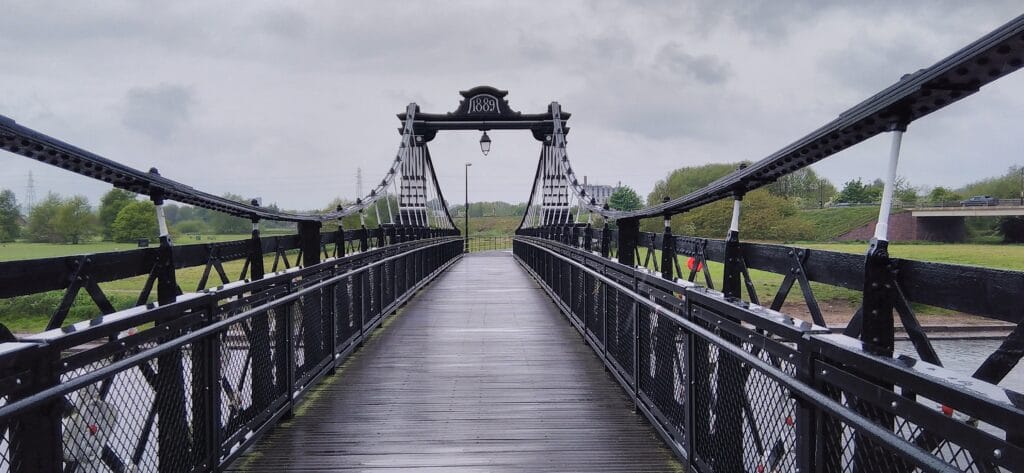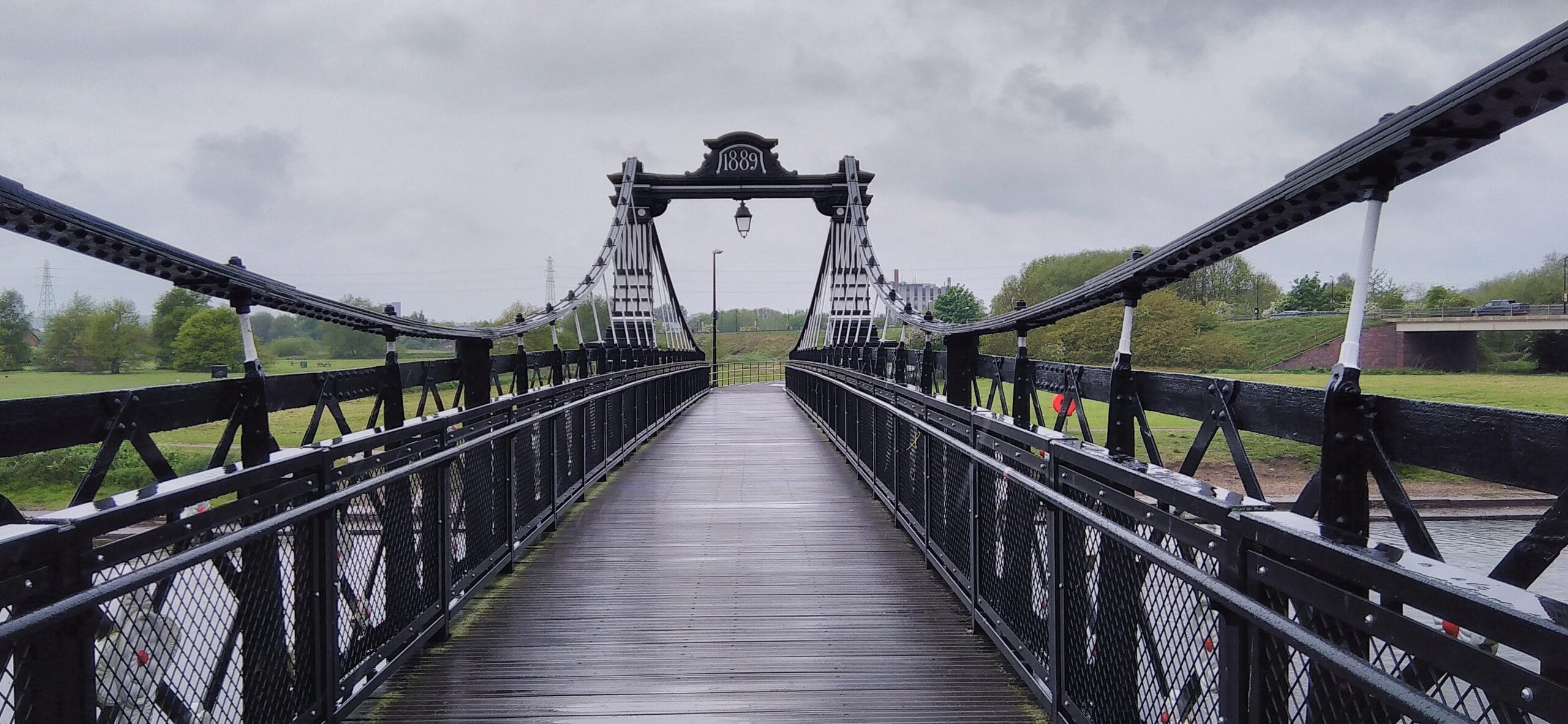Some places inspire us with their ancient allure more so than their standing beauty, and the Ferry Bridge of Burton upon Trent certainly fits the description. The second major crossing of River Trent in Burton, this one-of-a-kind semi-suspension bridge links the towncentre with the suburb of Stapenhill, nearly half a mile to the East of the river. Despite its age, the bridge has survived its original foundations with little modifications.
Some places inspire us with their ancient allure more so than their standing beauty, and the Ferry Bridge of Burton upon Trent certainly fits the description. The second major crossing of River Trent in Burton, this one-of-a-kind semi-suspension bridge links the towncentre with the suburb of Stapenhill, nearly half a mile to the East of the river. Despite its age, the bridge has survived its original foundations with little modifications.

The Ferry
According to a shred of substantial evidence found, the closest date for the ferry service starting is around the mid 13th century during the reign of Edward I ‘Longshanks.’ Nevertheless, the next piece of documented evidence refers to a Ferryman during the times of Richard II (1367-1400). It firmly validates the operations running under the control of the Burton Abbey. What’s more, a will dating back to 1496 of an Alice Bolde has turned up, revealing an endowment of at least two solid silver spoons for the maintenance of the ferry boats.
Going back to Henry VIII’s reign (1491-1547), after the King’s berserk monastery dissolving spree all over the country, he distributed the acquired lands amongst his most trusted advisors and council-men as a gesture to their support in his religious war. Just like almost all of Burton’s lands and those spread out beyond and as far as Cannock, the abbey and everything else related to it also came under Sir William Paget’s authority, principal secretary to His Majesty.
Although the old Burton Bridge persisted, William Paget felt it necessary to have an upstream crossing between Stapenhill and Burton and so an idea of a ferry boat was materialized to facilitate the workers in their transport. Not long after, and probably not even legitimately, there was a toll charged by the Paget family for crossing the river, a penny for a single trip. The toll system continued right until the ferry’s last day in the waters on the 3rd of April 1889.
Plans for a new Ferry Bridge
As the market town gained popularity for its notorious brewing industry, the population on both sides of the river also expanded exponentially. By the 1870s, a small suburb like Stapenhill itself had around 2000 inhabitants, a sharp increase from a mere 635 in 1850. More workers meant more demands for ferry service, and soon, two boats were navigating the river during peak times. It transported as many as 17,754 travelers a month, averaging to 700 journeys a day (of course, most of them made round trips for work) as per the 1879 census records commissioned by the council.
No doubt, frustrations grew over the outdated, inadequate ferry, and townsfolk convened meetings in demands of a footbridge. They even instigated others over the cynical benefit Lord Angelsey was reaping from the ferry’s income. Facing pressure, the Marquis of Angelsey applied for an Act of Parliament permitting him to build a bridge over River Trent near the site of the ferry. Hope rekindled among the regular ferry travelers, but much to everyone’s disappointment, the plans were never brought to fruition. Naturally, taking into account his gain, Lord Angelsey became the target of the town’s hit gossip.
Eventually, Marquis entered another Parliamentary act, but this time to sell the rights of the ferry to the Burton Cooperation, asking for a massive sum. Michael Arthur Bass (more fondly known as Lord Burton) generously stepped up to shoulder all the expenses for the new bridge on a condition that Cooperation buys all rights. The negotiations took additional few days, and finally, the council and Marquis shook hands on a total of £12,950 for the ferry, its rights, and the unenterprising footbridge built to appease the public.
Lord Burton handed over the project to a local engineering company, Thornewill and Warham Limited, principal suppliers of all the iron-works invested in the brewing construction in town. Previously in 1884, they also designed the nearby Andressey Bridge, linking the borough center with the island. After the final draft approval, the company began construction in 1888. It is hard to believe that a thriving company such as Thornewill’s, crumpled under heavy engineering in the 1920s and was bought by Samuel Briggs in 1929. The firm was so successful that in 1982, they ventured into the North American market, acquiring smaller companies and setting up offices. Today, Briggs of Burton has expanded to as far as Asia, experimenting with the markets in Shanghai, China.
Opening Ceremony
The bridge was finally ready for its grand opening on April 3rd, 1889. Despite the looming gray clouds and stormy weather, more than 8000 people turned up for the day to have the last ferry ride of their lifetimes. Soon the people of Burton were joined by Mr. Bass and his party, who drove from Rangemore Hall to Stapenhill House, currently Stapenhill gardens: home to Burton’s iconic swans.
As the clock stroked ten minutes to ten, the opening party hopped on for the last ferry ride from the Burton end. With no end to their enthusiasm, Burtonian gave them a loud hurrah as they crossed the bridge safely. On the bridge, the Mayor and Mr. Bass exchanged formalities, and the Mayor gifted Mrs. Burton a dish tray made out of pure silver, carved in a boat shape.
To pay off Marquis’s debt, the council had turnstiles built at Stapenhill end of the bridge and decided to put a toll charge of ½ a penny for crossers. Nine years in and Lord Burton paid for the remainder £230, freeing the bridge of its loans two months in advance to the expected date. It was so abrupt that those who missed the memo then kept their purchased tickets for the next day as souvenirs.
After the official party retired to a banquet held at St Paul’s Institute, Michael Bass announced his plans of the building of a raised viaduct across the muddy treks of meadows. It would lead from the Ferry Bridge to the gates of the Burton College. The construction wrapped up a year later from Ferry Bridge’s opening. Halfway across the viaduct, a shelter was erected with an inscription:
THIS BRIDGE AND VIADUCT
WERE PRESENTED TO THE BOROUGH OF BURTON UPON TRENT
BY THE RIGHT HONOURABLE MICHAEL ARTHUR BARON BURTON
AND THE BRIDGE WAS DECLARED FREE OF TOLL BY THE CORPORATION
ON THE THIRTEENTH DAY OF APRIL 1898
Restorations
In 1969, some eighty years after the original construction, the bridge was falling apart with rust eating away at its metal, and worse, water started seeping in through the cracks. To conserve the best parts of its engineering and eliminate the heavy elements exerting extra pressure on the bridge: the experts suggested taking down the ornamental linings and most of the bulky decorative iron-works, along with the four Victorian gas lamps, hung high from the ends of the bridge. All the repair work left the bridge stark from its previous splendor. Even worse, the original plum and gardenia colors were replaced with monotonous black and white scheme, stealing its most distinctive feature.
Recently on its 125th anniversary in 2014, a 400 membered social media group, “Friends of the Ferry Bridge,” took up campaigns to restore the rotting bridge. The Staffordshire County Council came up with a refurbishment plan, which was quickly agreed upon by the group and sent to East Staffordshire Borough Council to grant the application. The cost of the project totaled to around £1 million with an expected opening date of one year from the commencement.
All in all, this place is perfect for a moonlit walk after a hearty dinner or just taking out your cycles on a windy day. And did you know that the viaduct features a beautiful sculpture trail? Definitely exciting even for non-art lovers. So, do not forget to add the Ferry Bridge tour to your must-visit-destinations list. See you with the next attraction article!





